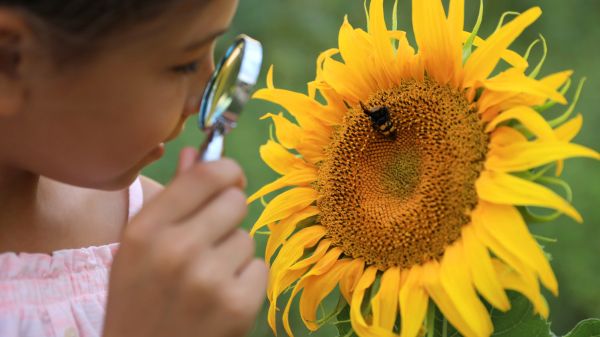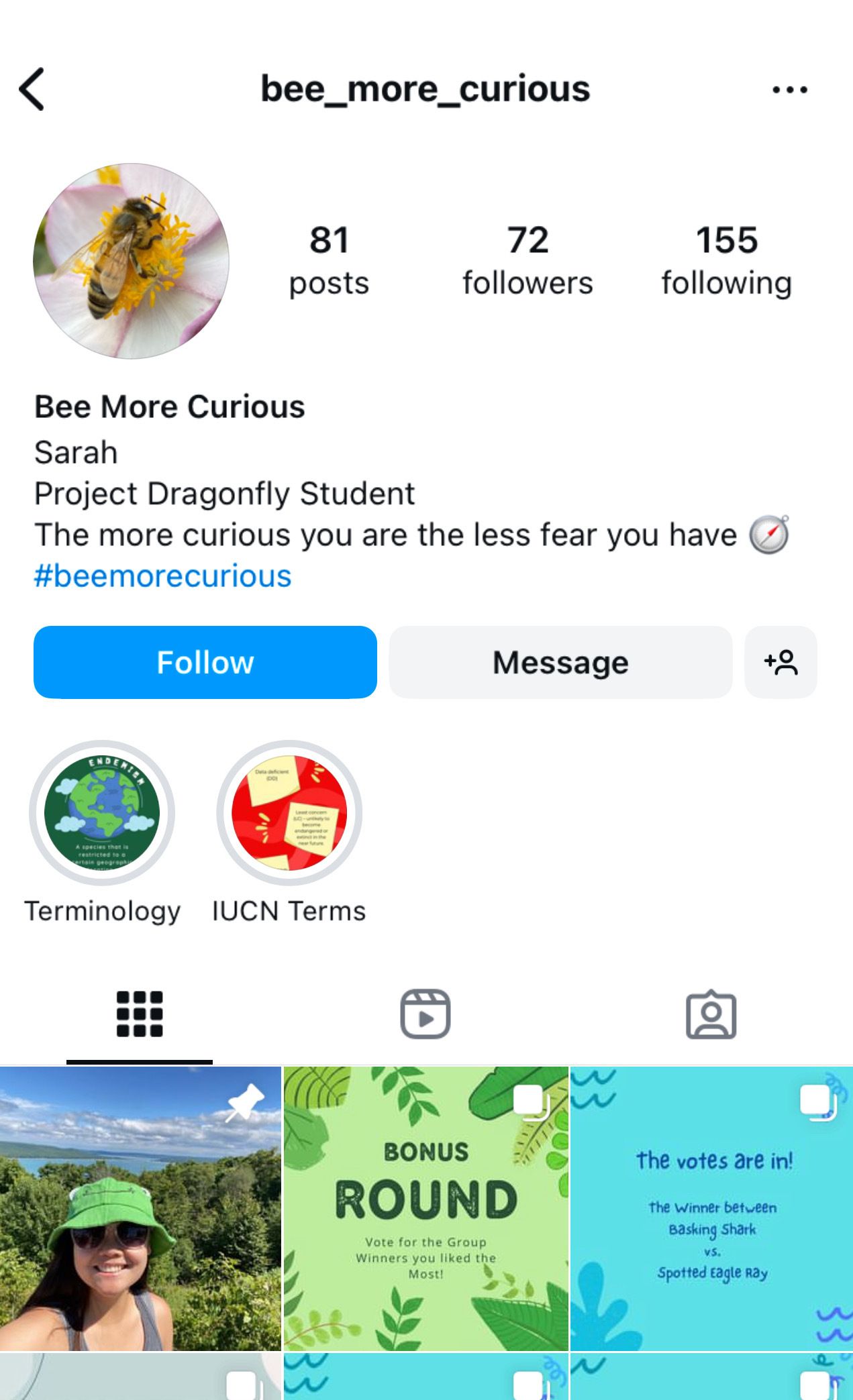Bee-ing More Curious with Social Media as a Tool for Biodiversity Learning

This guest blog post was written by Sarah Schaffner, a student in Miami University of Ohio's Project Dragonfly Master's program, and is being shared on eePRO with the writer's permission.
Today, it is not uncommon to find ourselves "doom scrolling", or scrolling endlessly without a goal, on platforms like Instagram, TikTok, Twitter, and Facebook. We are constantly seeing images of things we would not see on a typical day without the use of social media. For example, we can see the day-to-day lives of people worldwide, providing the opportunity to learn more about the world around us. Thus, social media is the perfect place to inspire and connect people with conservation topics outside the pressure of traditional education practices and in settings that encourage informal learning.
At the same time, many conservation groups on social media platforms are often not the most accessible to those just entering the conservation realm because of either technical language and terminology that can be intimidating or users not knowing what pages to look for when beginning their conservation journeys. This is where accounts need a more personalized way of interacting with new information in novel ways.
Over the last several years, bracket-style competitions for mammals have become increasingly popular, with March Mammal Madness and Katmai National Park's Fat Bear Week leading the way. These campaigns have done an outstanding job raising awareness of international and national conservation topics for stereotypically likable animals.
There has yet to be a group that has done something similar with less charismatic fauna, which is precisely what I set out to do by creating the Bee More Curious account on Instagram in March of 2023.

Bee_More_Curious Instagram page. Photo credit: Sarah Schaffner
Why Use Social Media for Conservation Messaging?
"Like” and “Follow for more" have become common phrases on social media platforms. Gamers, beauty bloggers, or other influencers often share all kinds of valuable lifestyles and fun tips and tricks. So much information is poured into social media platforms, making it a perfect place for informal learning and personalizing a user's interests. People can follow hashtags related to their areas of interest.
Science can be just as much of a hobby as any other topic out there. It does not always have to be purely academic all the time. Bee More Curious is just one example of how science can be shared accessibly across many learning communities, all while maintaining accurate and valuable information for conservation efforts.
Why Bee More Curious?
The Bee More Curious (@Bee_More_Curious) social media campaign was launched on Instagram in March of 2023 as a way for users to interact with the platform in a way they may not have previously. The account ran for roughly six weeks and used all of Instagram's major features: Regular posts with captions, Reels, Stories, Highlights, and relevant hashtags. The tags used were #BeeMoreCurious, #science, #conservation, #endangeredspecies, and general hashtags like #learning, #curiosity, and #new.

Posts from the Bee_More_Curious Instagram account. Photo credit: Sarah Schaffner
The first week was an introduction focused on preparing users for the focus groups, terminology, and voting in the brackets. There was even a call to action asking followers what species they would want to learn more about in the coming weeks.
Four main taxonomic groups were the focus: snakes and lizards (reptiles), sharks and rays (elasmobranchs), insects and arachnids (arthropods), and slugs and snails (gastropods). Each group was a topic for a week with posts sharing a mix of general information for the group and a handful of species-specific spotlights. The goal was to expose people to more information about species that are not as well represented in the media.
People may not gravitate towards certain species, typically because the species is odd-looking or because of the unknown or negative feelings towards a group of animals, which can be due to a lack of knowledge, cultural or religious beliefs, or learned behavior. A study done in 2017 by Melania Connor and Alistair Lawrence showed that adolescents are more likely to group animals based on learned positive or negative characteristics. However, when more information on the species is provided, individuals have a higher chance of having a neutral or positive attitude toward a previously disliked species. For instance, speaking about certain species' body shapes and why those body shapes are what helps that species bridge the gap between emotions and understanding.
These posts were written at a middle school level. During each Sunday’s Introduction Reel, body shape, coloration, and, in some cases, venom were addressed. In rare cases, a few posts had more scientific words, exposing followers to new vocabulary. Stories from the introduction week were saved as Highlights for quick references to the terms used. For example, a whole Highlight was dedicated to the International Union for Conservation of Nature (IUCN) Red List species status designations.
Like, Follow, and Vote!
The Bee More Curious account remains up but has been inactive for over a year now. But there are plans for it to come back with opportunities to change opinions on animals that are not always a fan favorite.
About the Writer
Sarah Schaffner is a student in Maimi University of Ohio’s Project Dragonfly Master’s program. Through the program, she has been able to explore interdisciplinary practices in the world of conservation. During Sarah’s with Dragonfly, she has traveled to Baja California, the Western Ghats in India, and Khao Yai National Park in Thailand. These experiences have informed her main area of interest in conservation education. The main focus of her studies has been on connecting people with nature through understanding less charismatic species and integrating traditional ecological knowledge.
References
Baksh, M. (2019). Natural Places & Digital Spaces: Challenges and Opportunities for Instagram in Biodiversity Conservation (Chapter 2: Exploring the Value, Use and Role of Instagram in Conservation Biology based on the Perception of Science Communicators).https://yorkspace.library.yorku.ca/xmlui/bitstream/handle/10315/36975/MESMP03267.pdf?sequence=1&isAllowed=y
Castillo-Huitrón, N. M., Naranjo, E. J., Santos-Fita, D., & Estrada-Lugo, E. (2020). The Importance of Human Emotions for Wildlife Conservation. Frontiers in Psychology, 11. https://doi.org/10.3389/fpsyg.2020.01277
Connor, M., & Lawrence, A. (2017). Understanding Adolescents’ Categorisation of Animal Species. Animals, 7(12), 65. https://doi.org/10.3390/ani7090065
Dabbagh, N., & Kitsantas, A. (2012). Personal Learning Environments, social media, and self-regulated learning: A natural formula for connecting formal and informal learning. The Internet and Higher Education, 15(1), 3–8. https://doi.org/10.1016/j.iheduc.2011.06.002
Nair, D. (2022, August 23). Using Instagram To Promote Wild Animal Conservation - Faunalytics. Faunalytics. https://faunalytics.org/using- instagram-to-promote-wild-animal-conservation/#:~:text=As%20a%20platform%20that%20promotes%20images%20with%20short,of%20wild%20animal%20images%20in%20promoting%20viewer%20engagement.


Comments
I appreciate this post because it provides a thoughtful, organized way to promote natural history and conservation learning within the digital landscape. Sarah's model is one that I think I could follow ... if I could just learn to love social media beyond LinkedIn. She at least got me thinking about how to delve into the realm I often avoid. Thank you!
Social media can be a powerful tool for biodiversity learning, offering a platform to share knowledge, raise awareness, and engage with experts and enthusiasts alike. It allows for real-time updates on conservation efforts, species discoveries, and environmental challenges. By being more curious and using social media, we can explore diverse ecosystems, connect with like-minded individuals, and inspire positive actions for protecting biodiversity.